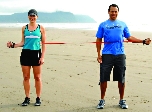Tubing Partner Exercises
Try these fun, effective partner exercises to build strength.

Mid-Row. Stand facing your partner. Intertwine the tubes, holding one handle each in your right and left hands. Back away from each other, arms fully extended, until there is some resistance on the tube. Begin in a squat stance with feet between hip and shoulder width apart. Slowly pull the tube, leading with your elbows, driving them backward. As you’re rowing backward, pinch your shoulder blades together and toward the ground. As you release your arms forward, squat toward the ground. Complete 1 set of 8–20 reps. This partner exercise helps improve posture.
Variations:
- Hold a static squat.
- Do single-arm rows. (Double up the tube in each arm.)
- Add rotation as you row.

External Rotation. Stand side-by-side with your partner, facing the same direction. Each of you holds one handle of one tube in your outside arm. Your outside elbow, bent at 90 degrees, is anchored at your waist. Keeping your upper arm at your side, slowly rotate your forearm away from your body. Complete 1 set of 8–20 reps for each arm. This partner exercise strengthens weak rotator cuff muscles.
Variations: Try this exercise standing on one leg

Trunk Rotation. Stand facing your partner. Wrap the tubes around each other and each hold one handle in your right and left hands. Back away from each other until there is some light resistance on the tube. Contract your abdominals inward and maintain good posture throughout the entire exercise. Begin by rotating your torso one way while your partner rotates in the other direction. Slowly return to the starting position. Perform 8–20 reps on each side.
Variations:
- Keep the lower body static.
- Rotate/pivot through the lower body.
- Add one-arm rotation, to engage more of your upper body.

Lunge and Full-Body Rotation. Start facing sideways to your partner, holding one end of one tube in your hands. Lunge your outside leg (leg farthest away from your partner) forward while simultaneously rotating to the outside of your body. Press up and backward and do 8–20 reps one side; then repeat on the other side. Be sure that, while lunging, your front knee stays over your front foot and you always push from the leg in front. Both people lunge simultaneously.
Variations:
- Step forward (entry-level variation).
- Perform a deep lunge (more advanced variation).



.jpeg)
.jpeg)